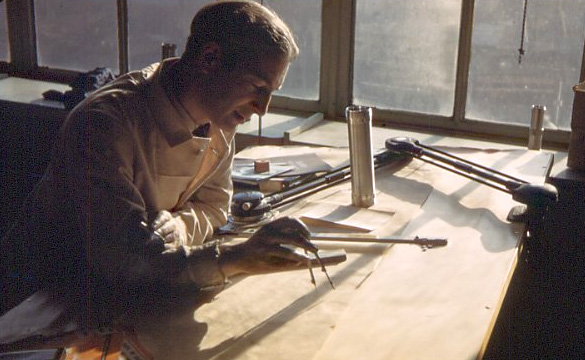Fifty-Seven years ago today, an assistant staff engineer working for Chevrolet recognized the burgeoning hot rod market was made up of young men who invariably turned to Ford parts and accessories for performance. The engineer also deduced that once these men progressed in age and income, they would trade in their jalopies for used Fords and then for new Fords. For Chevrolet to be able to compete for these new performance-minded customers, the company’s anticipated V8 engines should also be made available with a ready line of engineered performance parts including cams, pistons and valves. And so the assistant staff engineer wrote a memo to his boss detailing this epiphany.
Little did Zora Arkus-Duntov realize the paradigm shift that would take place after he penned his now famous letter “Thoughts Pertaining to Youth, Hot Rodders, and Chevrolet” on December 16, 1953 to his boss, Chevrolet Chief Engineer Ed Cole.
Thoughts Pertaining to Youth, Hot Rodders, and Chevrolet
The Hot Rod movement and interest in things connected with hop-up and speed is still growing. As an indication: the publications devoted to hot rodding and hop-upping, of which some half-dozen have a very large circulation and are distributed nationally, did not exist some six years ago.
From cover to cover, they are full of Fords. This is not surprising that the majority of hot rodders are eating, sleeping, and dreaming modified Fords. They know Ford parts from stern to stern better than Ford people themselves.
A young man buying a magazine for the first time immediately becomes introduced to Ford. It is reasonable to assume that when hot rodders or hot rod-influenced persons buy transportation, they buy Fords. As they progress in age and income, they graduate from jalopies to second-hand Fords, then to new Fords.
Should we consider that it would be desirable to make these youths Chevrolet-minded? I think that we are in a position to carry out a successful attempt. However, there are many factors against us:
1. Loyalty and experience with Ford.
2. Hop-up industry is geared with Ford.
3. Law of numbers: thousands are and will be working on Fords for active competition.
4. Appearance of Ford’s overhead V-8, now one year ahead of us.
When a superior line of GM V-8s appeared, there where remarkably few attempts to develop these, and none too successful. Also, the appearance of the V-8 Chrysler was met with reluctance even though the success of Ardun-Fords conditioned them to the acceptance of Firepower.
This year is the first one in which isolated Chrysler development met with successes. The Bonneville records are divided between Ardun-Fords and Chryslers.
Like all people, hot rodders are attracted by novelty. However, bitter experience has taught them that new development is costly and long, and therefore they are extremely conservative. From my observation, it takes an advanced hot rodder some three years to stumble toward the successful development of a new design. Overhead Fords will be in this stable between 1956 and 1957.
The slide rule potential of our RPO V-8 engine is extremely high, but to let things run their natural course will put us one year behind – and then not too many hot rodders will pick Chevrolet for development. One factor which can largely overcome this handicap would be the availability of ready-engineered parts for higher output.
If the use of the Chevrolet engine would be made easy and the very first attempts would be crowned with success, the appeal of the new RPO V-8 engine will take hold and not have the stigma of expensiveness like the Cadillac or Chrysler, and a swing to Chevrolet may be anticipated. This means the development of a range of special parts – camshafts, valves, springs, manifolds, pistons, and such – should be made available to the public.
To make good in this field, the RPO parts must pertain not only to the engine but to the chassis components as well. In fact, the use of light alloys and brake development, such as composite drums and discs, are already on the agenda of the Research and Development group.
These thoughts are offered for what they are worth: one man’s thinking aloud on the subject.
Signed,
Zora Arkus-Duntov
December 16, 1953
With the inclusion of the small-block Chevy V8 in the 1955 Corvette, a new era was born as Zora and his engineers set upon an upward path of wringing as much performance out of those early 283s, 327s and 350 cubic inch V8 engines and then making those performance parts available to the everyman.
To date, over 90 million small block Chevy engines have been produced and the spirit is alive and well with GM’s new focus on the hot-rod market with the e-rod crate engine lineup. It’s not a surprise that hot rodders today turn to the Chevy 350 small block as their engine of choice. Big power does come in small packages and an attractive price point usually seals the deal.
While the performance market is much different today than 57 years ago, what’s unique about Chevy’s position today is that its attributable to one man who had vision and faith in the organization to make it succeed.
The original letter to Ed Cole can be found on display at the National Corvette Museum in Bowling Green, Kentucky.
Source:
Photo: Zora Arkus-Duntov on FaceBook
Related:
2010 SEMA: 1963 Corvette Grand Sport Replica Featuring the New GMPP E-ROD LSA Crate Engine
Celebrating Zora’s 100th Birthday
-



![[VIDEO] New Apple TV+ Series Stars Colin Farrell and a 1966 Corvette Sting Ray Convertible [VIDEO] New Apple TV+ Series Stars Colin Farrell and a 1966 Corvette Sting Ray Convertible](https://www.corvetteblogger.com/images/content/uploads/2024/04/040324_11-218x150.jpg)
![[ACCIDENT] Chief’s WR Rashee Rice Admits to Involvement in the Lamborghini-Corvette Crash in Dallas Details continue to trickle out regarding the multi-car crash on Saturday in Dallas between a Lamborghini and a Corvette Stingray registered to Chiefs wideout Rashee Rice.](https://www.corvetteblogger.com/images/content/uploads/2024/04/040324_7-218x150.jpg)